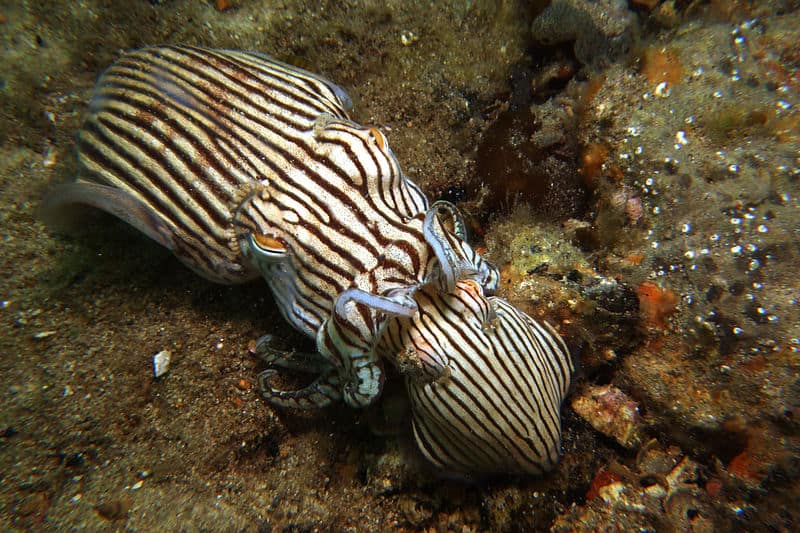
Striped Pyjama Squid Facts
- Firstly, the Striped Pyjama Squid is proof that names can be misleading. This holds true because this unusual ocean creature is not actually a species of squid but actually cuttlefish.
- They are also masters of camouflage and possesses the enviable ability to change their appearance at will. Also, they are able to effect this color change extremely rapidly.
- Despite their diminutive size, they are dangerous as they possess a rather powerful venom which makes them one of the very few known venomous cephalopods.
Striped Pyjama Squid Physical Characteristics
The Striped Pyjama Squid is quite diminutive. Their mantle usually reaches only 2 in (5 cm) in length and their appendages are also quite short. These average only 1 in (2.5 cm) long.
The species possesses eight arms, as well as two tentacles used for feeding and are covered in numerous small suckers.
Their most noteworthy feature is their natural coloring. This is a creamy white color, with large horizontal dark brown stripes. The eyes protrude and possess a bright orange lid.
Most interestingly, this creature is a master of camouflage. This is due to their ability to change their color through a wide range of the spectrum from white to purple.
- Kingdom: Animalia
- Phylum: Mollusca
- Class: Sepiida
- Family: Sepiadariidae
- Genus: Sepioloidea
- Species: S. lieolata
Striped Pyjama Squid Habitat and Ecology
The remarkable Striped Pyjama Squid is endemic to the Indo-Pacific region. In addition, the vast majority of their numbers are concentrated along the Great Barrier Reef just off the Australian coast.
Their preferred habitat consists of either loose sand or beds of seagrass in shallow water. They also rarely live at depths exceeding 60 ft (18.3 m).
The animal buries itself in the sand by day and emerges at night to hunt. They are also quite voracious and feed primarily on shrimp and small fish.
Very little is known about their mating habits. The female deposits her eggs in small clumps, under coral rubble or rocks. The young are born with their distinctive stripes fully visible. Data regarding their conservation status is insufficient. Consequently, the IUCN has no official listing for this species.
Check out our articles on Pfeffer’s Flamboyant Cuttlefish, Hawaiian Bobtail Squid, Glass Squid, Striped Pyjama Squid, Armhook Squid
